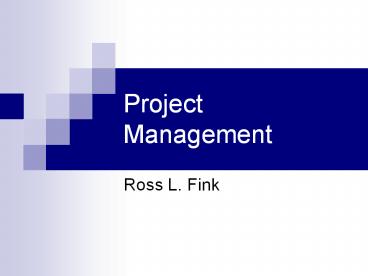Project Management PowerPoint PPT Presentation
Title: Project Management
1
Project Management
- Ross L. Fink
2
Definition of Project
- A project is a specific, finite task to be
accomplished.
3
Brief History
- Modern Project Management can be traced to the
Manhattan project. - Early project management dealt with large complex
projects or RD (weapons systems) - Today -- Project management is more important
than ever.
4
Importance of Project Management Today
- More customization in manufacturing
- Shorter product life cycles
- Use in service organizations
- Nonprofit sector
5
Why Project Management?
- Better control
- Better customer relations
- Shorter development time
- Lower costs
- Higher quality and reliability
- Higher profits
- Better interdepartmental coordination
- Better worker morale
6
Characteristics of a Project
- One-time focus
- Specific purpose and desired results
- Identifiable start and finish
- Time fence (or due-date) for completion
- Involvement of cross-functional work team
- Limited set of resources
- Logical sequence of events
- A clear client (user, customer) of results
7
Project Management Tools
- Major tools developed in the 1950s
- PERT - Program Evaluation and Review Technique -
Polaris Missile (NAVY) - CPM - Critical Path Method (CPM) - DuPont and
Remington Rand - Maintenance of Chemical Plant
8
Project Performance Objectives
- PCT Objectives
- Good, Fast, Cheap
Performance
Time
Cost
9
Reason for Project Failures
- Unrealistic expectations
- Poor project leadership
- Poor project planning
10
The Project Manager is Responsible to
- Superiors
- Team
- Customer or Sponsor of project
11
A Project Manager Needs to
- Communicate -
- Importance of project
- Role others play in project
- Importance of their contribution
- With customers
- Understand project dimensions -
- Technical
- Cultural
- Political
12
Work Breakdown Structure (WBS)
- Breaks the Program (or Project) into smaller and
smaller units of work. The following are common
levels of work - Program
- Project
- Task
- Subtask
- Work Package
13
Why Use WBS
- Provides a logical means of identifying the
activities of a project - Provides structure to the project plan
- Different levels of WBS can be used for control
by different individuals
14
Types of WBS
- Outcome (things)
- Task
- Task-outcome
15
WBS Procedure
- Simply ask What will have to be done in order to
_________ - Dont worry about sequencing at this point
16
Stopping Rules For WBS
- Level of detail is too great to be useful
- Control to smallest time unit used for control
- Typically, no more than 5 to 6 levels is
appropriate - For large project, no more than 20
17
PERT Diagrams
- PERT (or Network) diagrams showing the
relationship between activities - There are more than one way of constructing these
networks, we will use what is called
activities-on-the-node (AON) or
activities-in-the-box. This is the same as MS
Project
18
PERT Diagram Notation
- Box or circle (node) represents the activity
- Arrow (arc) represents the relationship between
activities
19
Example
Activity Immediate Predecessor
A --
B A
C A
D B,C
E C
20
PERT Diagram
21
Modeling Time
- Simple model assumes times are deterministic
(constant) - More elaborate models allow stochastic
representation (most common being one that uses 3
time estimates)
22
Example
23
Example - Maximum Time
- Sequential
- Sum of all task times
- In our example 21 periods
24
Finding time
- ES and EF go forward through PERT diagram (ES
Time EF) - LS and LF go backwards through PERT diagram (LF -
Time LS) - Slack is LS - ES or LF - EF
25
PERT Diagram
26
PERT Diagram with Times
27
Critical Path
- A-C-E
- Significance--critical path determines project
completion time
28
Example in MS Project

